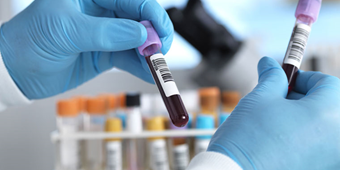- Back and Spine
- Bone and Joint Health
- Cardiology And Vascular Health
- Health Topics
- Joint Conditions/Injuries/Treatment
- Joint Pain/Pain Management
- Vascular Health
Leg Pain: Is It Spinal Stenosis or PAD?

Find Your Perfect Match
Answer a few questions and we'll provide you with a list of primary care providers that best fit your needs.
Are you bothered by leg pain?
Two medical conditions commonly associated with leg aches – peripheral artery disease (PAD) and lumbar spinal stenosis – have very different causes.
Read on to learn more about the two conditions, how they differ, and what you need to do if you think one of them might be causing your leg pain.
PAD: Blocking Blood Flow To the Legs
 Cholesterol, calcium, and other substances can build up in arteries damaged by smoking, high cholesterol, high blood pressure, diabetes, and other risk factors. Eventually, plaque starts to form and can harden. This causes
atherosclerosis, or hardening of the arteries.
Cholesterol, calcium, and other substances can build up in arteries damaged by smoking, high cholesterol, high blood pressure, diabetes, and other risk factors. Eventually, plaque starts to form and can harden. This causes
atherosclerosis, or hardening of the arteries.
Sometimes, part of the plaque will break off, and block (partially or completely) the blood flow. This limits the flow of oxygen-rich blood to your heart, brain, and other organs, as well as your arms and legs. This is PAD.
PAD, also known as peripheral vascular disease (PVD), can cause pain and numbness in your legs, and raises the risk of infection. If severe enough, lack of blood flow can cause gangrene (tissue death), and worst case, can lead to leg amputation.
People with PAD often show no signs of it. That’s why it’s important that you ask your doctor to check for PAD if you are older than 70; over 50 with a history of smoking or diabetes; or under 50 with a history of diabetes and one or more risk factors for atherosclerosis.
Signs and symptoms of PAD include:
- Pain, numbness, tingling, aching, or heaviness in the leg muscles when walking or climbing stairs
- Cramping in the legs, buttocks, thighs, calves, and feet
- Weak or no pulse in your legs or feet
- Sores or wounds on your toes, feet, or legs that heal slowly or won’t heal
- Pale or bluish skin color
- Leg feels cool to the touch
- Poor toenail growth and decreased leg hair growth
- Erectile dysfunction, especially in men with diabetes
Typically, you’ll notice PAD symptoms more when you’re walking or active, and they’ll probably go away when you rest.
Typically, you’ll notice PAD symptoms more when you’re walking or active, and they’ll probably go away when you rest.
Diagnosing And Treating PAD
To diagnose your symptoms, your doctor will consider your and your family’s medical histories and conduct a physical exam. He may conduct a simple office test, called an ankle-brachial index or ABI, which measures blood pressure in the arms and legs. Other tests may include angiography (X-ray) of the arteries, an ultrasound, and/or an MRI or CT scan.
To treat your PAD, you’ll be asked to make healthy lifestyle changes, including a healthier diet, exercise, and quitting smoking. Your physician may also recommend surgical or medical procedures, including:
- Bypass grafting. This surgery uses a blood vessel from another part of your body or a synthetic tube to make a graft. This graft bypasses (goes around) the blocked part of the artery, allowing blood to flow around the blockage.
- Angioplasty and stents. During angioplasty, a catheter (thin tube) with a balloon at the tip is inserted into a blocked artery. The balloon is then inflated, which pushes plaque against the artery wall, widening the artery and restoring blood flow. A stent (a small mesh tube) may be placed in the artery during angioplasty, which helps keep the artery open.
- Atherectomy. Using a catheter, a physician inserts a small cutting device into the blocked artery. The device shaves or cuts away plaque, which is then removed from the body through the catheter or washed away in the bloodstream. Sometimes, a laser is used instead of a cutting device to dissolve the blockage.
Your doctor might also prescribe medication. This might include aspirin or clopidogrel (Plavix) to keep your blood from clotting in your arteries; Cilostazol, which works to dilate (enlarge) the affected artery; cholesterol-lowering medicine; and/or pain relievers.
Spinal Stenosis: It Starts In the Back
Like PAD, spinal stenosis can cause leg pain. But in this case, the problem starts in the spine.
Spinal stenosis happens when another condition or injury causes the spine to narrow in one or more places, putting pressure on the spinal cord or nerves that branch out from the compressed areas and causing pain. It typically occurs in men and women over the age of 50, but it can strike younger people.
Sometimes, there are no symptoms with spinal stenosis, or they may appear slowly and worsen gradually. Symptoms include:
- Numbness, weakness, cramping, or pain in the legs
- Pain going down the leg
- Loss of feeling in one or both legs
- Foot problems
Spinal stenosis may be caused by:
- Osteoarthritis, which is the most common cause and which is common in people over 50
- Inflammatory spondyloarthritis, a condition that causes joint inflammation
- Inherited conditions, like being born with a small spinal canal or a curved spine
- Tumors of the spine
- Injuries
- Paget’s disease, which involves abnormal bone growth
- Excess fluoride in the body
- Calcium deposits on the ligaments that run along the spine
To diagnose spinal stenosis, your doctor will ask about your medical history, give you a physical exam, and order an X-ray, MRI scan, CT scan, or an electromyogram (EMG).
There is no cure for spinal stenosis, but treatments to reduce the pain and increase your flexibility include:
- Medications to reduce swelling or pain
- Lower back braces
- Cortisone injections
- Alternative treatments, such as chiropractic treatment and acupuncture, although more research is needed on their effectiveness
- Surgery to decompress the spine if you have symptoms that affect walking or cause bowel, bladder, or nervous system problems
- Exercise to strengthen muscles and improve flexibility
If you’re unsure what’s hurting your legs, contact your health care provider as soon as possible. Don’t try to diagnose yourself. The earlier the cause is determined, the more likely you’ll find an effective and lasting treatment to help ease the pain.
Find Your Perfect Match
Answer a few questions and we'll provide you with a list of primary care providers that best fit your needs.
Sources: National Heart, Lung, and Blood Institute (National Institutes of Health); Medline Plus; Johns Hopkins; National Institute of Arthritis and Musculoskeletal and Skin Diseases (National Institutes of Health); American College of Rheumatology




